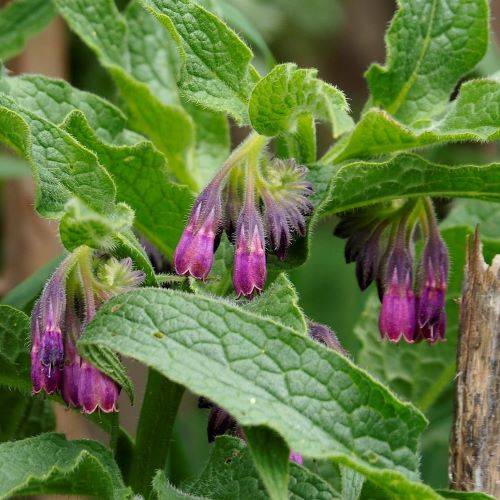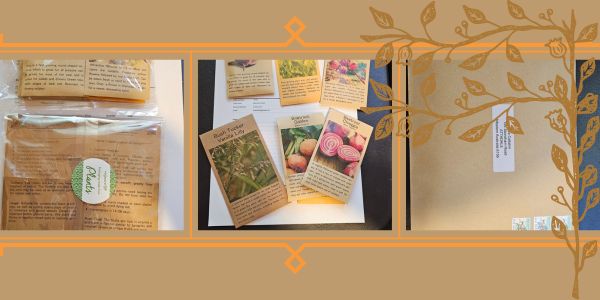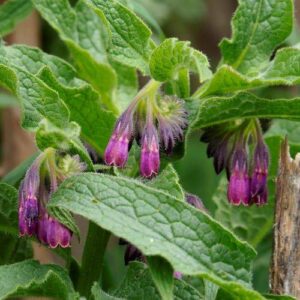Comfrey
$6.59
Symphytum Officinale
- Seed count 15
- Soil Improver
- Perennial
In stock
Description
If there’s one plant that deserves a permanent spot in any serious gardener’s patch, it’s comfrey. It has been grown and used for centuries across Europe, especially in damp, grassy places where it thrives with gusto. But it’s made itself at home just as easily here in Australia, where it flourishes in gardens, orchards, paddocks, and even forgotten corners of the yard.
It’s known for its coarse, hairy leaves that are broad and deep green, packed with nutrients and trace minerals drawn up from deep in the soil. Come summer, this fast-growing perennial puts on a lovely display of bell-shaped flowers, often in hues of soft blue, mauve, or creamy white and the bees and beneficial insects absolutely adore them
It grows tall and wide usually between 60 to 90cm in height, and just as wide if left unchecked. The leaves form a big, leafy rosette, giving the plant a lush, almost tropical look. It fills space quickly and brings a dense, green presence to wherever it’s planted.
For those who grow with a permaculture mindset or follow more traditional, low-input gardening styles, comfrey is a living toolbox you can turn to again and again.
Let’s start with the soil. Comfrey is a champion green manure. Its deep taproots mine nutrients from way down in the soil profile gathering minerals that would otherwise be out of reach for most garden plants. When those giant leaves are chopped and dropped or used as mulch, all those nutrients are made available again, right at the soil’s surface. It’s like giving your garden a free, slow-release fertiliser straight from nature.
In the compost heap, comfrey is pure gold. Those same leaves break down rapidly and add a rich nitrogen boost to your pile, helping woody materials decompose faster and giving your compost a healthy balance. Some gardeners use it to make comfrey tea, a fermented liquid fertiliser made by steeping the leaves in water for a couple of weeks. Plants love it.
It has long-standing traditional uses as a medicinal herb. The roots and leaves are full of compounds that have been prized by herbalists for generations. And for gardeners who like to mix a little traditional wisdom with their green thumbs, it offers an extra layer of value.
So if you’re looking for a plant that pulls its weight, adds resilience to your garden, and quietly supports everything else you grow, comfrey might just be your new favourite.
| Method: Sow seedlings | Soil Temp: 10°C - 25°C |
| Cool Mountain: Nov - Feb | Position: Full sun |
| Arid: Aug - Jan | Row Spacing: 10cm apart |
| Temperate: Sep/Nov - Mar/June | Planting Depth: 3mm |
| Sub Tropical: May - Oct | Harvest: 365 days |
| Tropical: Jun - Aug | Plant Height: 1.2m |
Comfrey seeds need a bit of gentle encouragement to wake up and grow. Unlike some quick germinators, they require stratification, a cold period to simulate winter. This helps break seed dormancy and improves germination rates.
🧊 Step 1: Stratify Your Seeds
- When to stratify: Late autumn to early winter (May – July in most regions)
- How to do it:
- Place seeds in a labelled, ziplock bag with a handful of damp (not soggy) sand or vermiculite.
- Pop the bag into the fridge (not freezer!) for 4 – 6 weeks.
- After stratification, sow them in early spring as temperatures rise.
🌼 Option 1: Sowing in Trays
This is the easiest way to control growing conditions and monitor germination.
Best for: Cool and temperate climates, small spaces, and gardeners who like to keep a close eye on seedlings. Higher success rate as will reduce slug and snail damage.
How-To:
- Fill seed trays or small pots with quality seed-raising mix.
- Sow seeds about 3 mm deep, just enough to cover.
- Water gently and keep moist but not wet.
- Germination can be slow, 2 to 6 weeks, so don’t give up!
- Once seedlings have developed 2 – 3 sets of true leaves, pot them up into larger containers or harden off for transplanting into the garden.
💡 Tip: Keep trays in a bright but sheltered spot. Comfrey doesn’t love strong direct sun as a seedling.
🌾 Option 2: Direct Sowing
You can also sow seeds straight into the garden, especially in mild climates where frost isn’t an issue.
Best for: Gardeners in warmer regions or with established garden beds and good weed control.
How-To:
- Choose a sunny to partly shaded spot with rich, well-draining soil.
- Sow in early spring after the risk of frost has passed.
- Prepare the soil well as comfrey stays put for years! Loosen soil deeply.
- Sow seeds 3 mm deep and water well.
- Keep moist during germination.
- Thin to 60 – 90cm apart as comfrey grows big and wide!
🌿 Heads up: Once it’s in, it’s in! Choose your site carefully, because comfrey’s deep taproots make it very hard to move later.
🌼 Growing On
Comfrey is a low maintenance powerhouse once established.
Care Tips:
- Watering: Water well while young. Once established, comfrey is fairly drought-tolerant.
- Feeding: It thrives on compost and worm castings, but doesn’t need much once its roots are down.
- Mulching: Helps keep weeds down around new plants.
- Cutting back: Slash leaves 2 – 5 times a year for mulch or compost as this encourages new growth.
- Invasiveness: Deadhead flowers if self-seeding is unwanted.
💡 Tip: Containers: Use 20L+ pots with quality potting mix to control spreading.
🌻 Companion Planting with Comfrey
Comfrey is like a garden bestie, generous, grounded, and always helpful. Here’s how it supports other plants:
✅ Benefits:
- Dynamic accumulator: Its deep roots mine nutrients (like potassium, calcium, and iron) from the subsoil.
- Green manure/mulch: Use chopped leaves around fruit trees, veggies, or garden beds.
- Compost booster: Speeds decomposition due to high nitrogen content.
- Pollinator magnet: Bees adore the purple-pink bell flowers.
🌿 Best Companion Uses:
| Comfrey Near… | Why It Works |
|---|---|
| Fruit trees | Mulch and nutrient boost; suppresses weeds. |
| Vegetable beds | Use leaf mulch between rows or in compost. |
| Tomatoes & potatoes | Loves the extra potassium from chopped comfrey mulch. |
| Chicken coop | Add to bedding or compost for its great odour control and nutrient cycling! |
🚫 Avoid planting too close to shallow-rooted crops as it can outcompete them.
🌼 Seed Saving Guide for Comfrey
Step-by-Step:
- Let flowers mature
- Allow flowers to dry and form small, prickly seed pods.
- Pods will turn brown and drop so watch closely, as they can fall quickly!
- Harvest
- Pick the pods just before they drop.
- Dry indoors in a paper bag until they open naturally.
- Shake out the seeds which are small, dark brown/black, and oval-shaped.
- Drying & Storage
- Dry seeds for a few extra days in a well-ventilated spot.
- Store in a labelled envelope or jar in a cool, dry place, the fridge is ideal.
🕰️ Viability: Comfrey seeds can stay viable for 2 – 3 years if kept cool and dry.
🧊Troubleshooting & Maintenance
- Pests:
- Slugs/Snails: Handpick at night; use beer traps.
- Rust Fungus: Remove infected leaves; avoid overhead watering.
- Pruning: Cut back to ground in late autumn (cold zones) or spring (warm zones).
- Harvesting: Wait 1 year for established plants; take outer leaves first. Yields improve yearly.
💡Final Tips for Success
✅ Permanent Spot: Choose carefully as comfrey resists relocation due to regenerative roots.
✅ Nutrient Boost: No fertiliser needed; thrives in poor soils.
❌ Invasiveness: Contain roots with buried pots or root barriers.
Postage Charge
Orders under $30 attract a $4.95 shipping charge. Orders $30 and above have free shipping.
Order Times
Seed orders are normally dispatched within three business days. You will receive an email when seeds are mailed out.
Postage Days
Seeds are mailed out Monday to Friday at 1pm. Except for the Friday of long weekends.
Postage Times
WA 2-3 Days: SA,NT 3-5 Days: NSW, ACT, QLD, VIC: 5-7 Days
Carrier
We use Australia Post Letter Postage for the majority of orders
Not only are our seeds packed in recycled paper envelopes, we keep the theme going when we post out website orders. To protect your seeds from moisture and the letter box munchers (snails), we use a very special plastic free material made from plants. They are then put into recycled mailing envelopes. Green all the way 💚🌿

















Not planted as yet due to hot weather
Excellent service, thanks, will buy again.